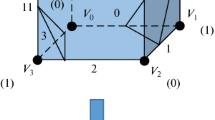Abstract
The chapter identities and analysis methods that can be used to solve the problem of volume visualization, using the capabilities of standard GPU. The average computational complexity of volume visualization algorithms is estimated. The computational complexity of volume rendering is analyzed. An overview of alternative implementations of the volume visualization problem and a comparison of the proposed solution with a system based on a highly specialized hardware accelerator for volume visualization is given.
One of the actual applied tasks for any field of science that works with three-dimensional computational or experimental data is their visualization using a computer. Methods for obtaining data can be very different: from modeling to scanning using tomography, ultrasound, and various methods used in medicine, archeology, seismography, geological exploration, etc. In general, volume data is a three-dimensional array of cubic elements (voxels) representing units of 3D space. As a rule, this array contains information about each point in three-dimensional space. Volumetric visualization is the process of obtaining an image of volumetric data on a computer screen to represent an object or phenomenon in a realistic way, with a visual representation of its internal structure. Obviously, we can hardly hope in the near future for a purely software implementation of volume visualization in real time, even in a multiprocessor system, without the cost of creating processing accelerators – optimization algorithms and hardware. Therefore, it is important to further develop the fundamental theory in the field of volumetric visualization, as well as to develop advanced methods of volumetric visualization.
The aim of the work is to research the features of using known and original volumetric visualization methods and evaluation of the quality images and performance.
The object of the research work is to analyze the volumetric visualization methods and comparison of the proposed approaches with well-known volume visualization systems.
The subject of the research is the clut-texture and shaders, combined method of visualization of functionally defined surfaces and 3D textures, as well volume rendering in WebGL.
The scientific novelty of the work consists in the development of the volume rendering methods. The problem of volume visualization can be solved using the capabilities of standard GPU. The ability to program the accelerator pipeline allows you to implement specific functionality. At the same time, both volume visualization and polygonal graphics technologies can be used together. A combined method for visualizing four types of data is proposed: analytical description of an object based on perturbation functions; voxel-based terrain; coordinates of vertexes with transformation matrices, the intensity and direction of sunlight, as well as its attenuation and scattering coefficients; and volume clouds based on three-dimensional textures. The mathematical foundations of volumetric rendering and its implementation in WebGL 2 are given to create an interactive volumetric renderer that works completely in the browser.
Access this chapter
Tax calculation will be finalised at checkout
Purchases are for personal use only
Similar content being viewed by others
References
Kalawsky, R.S.: The Science of Virtual Reality and Virtual Environments. Addison-Wesley, Boston (1993)
Udupa, J., Hung, H.M., Chuang, K.S.: Surface and volume rendering in 3D imaging: a comparison. J. Digit. Imaging 4(3), 159–168 (1991). https://doi.org/10.1007/bf03168161
Bajaja, C.L., Coyleb, E.J., Lin, K.N.: Arbitrary topology shape reconstruction from planar cross sections. J. Graph. Models Image Process. 58(6), 524–543 (1996). https://doi.org/10.1006/gmip.1996.0044
Matheus, C.M., Furuie, S.S.: Automatic coronary wall segmentation in intravascular ultrasound images using binary morphological reconstruction. Ultrasound Med. Biol. 37(9), 1486–1499 (2011). https://doi.org/10.1016/j.ultrasmedbio.2011.05.018
Grevera, G.J., Udupa, J.K.: Shape-based interpolation of multidimensional grey-level images. J. IEEE Trans. Med. 15(6), 881–892 (1996). https://doi.org/10.1109/42.544506
Chen, B., Kaufman, A., Tang, Q.: Image-based rendering of surfaces from volume data. In: Volume Graphics Proceedings of the Joint IEEE TCVG and Eurographics Workshop in Stony Brook, New York, USA, 21–22 June 2001, pp. 279–295 (2001). https://doi.org/10.1007/978-3-7091-6756-4_19
Pfister, H., Hardenbergh, J., Knittel, J., Lauer, H., Seiler, L.: The VolumePro real-time ray-casting system. In: Proceedings of SIGGRAPH 1999, Los Angeles, CA, pp. 251–260, August 1999. https://doi.org/10.1145/311535.311563
Vyatkin, S., Romaniuk, O., Dudnyk, O.: GPU-based rendering for ray casting of multiple geometric data. In: International Conference ACIT – Advanced Computer Information Technologies, Ceske Budejovice, Czech Republic, 1–3 June 2018, pp.195–198 (2018). eLIBRARY ID: 39134676. https://acit.tneu.edu.ua
Vyatkin, S.I., Romanyuk, O.N., Pavlov, S.V., Romanyuk, O.V., Snigur, A.V., Komada, P., Smailova, S., Yeraliyeva, B.Y.: A function-based approach to real-time visualization using graphics processing units. In: Proceedings of the SPIE 11581, Photonics Applications in Astronomy, Communications, Industry, and High Energy Physics Experiments, Wilga, Poland (2020). https://doi.org/10.1117/12.2580212
Perlin, K.: Improved noise. ACM Trans. Graph. (TOG) 21(3), 681–682 (2002). https://doi.org/10.1145/566654.566636
Fox, M.: Optical Properties of Solids, 2nd edn., p. 3. Oxford University Press, Oxford (2010). ISBN 978-0199573370
Author information
Authors and Affiliations
Corresponding author
Editor information
Editors and Affiliations
Rights and permissions
Copyright information
© 2021 The Author(s), under exclusive license to Springer Nature Switzerland AG
About this paper
Cite this paper
Vyatkin, S.I., Romanyuk, O.N., Chekhmestruk, R.Y., Romanyuk, S.O., Romanyuk, O.V. (2021). Comparison of Volume Rendering Methods Using GPU and Specialized Volumetric Accelerator. In: Vorobiyenko, P., Ilchenko, M., Strelkovska, I. (eds) Current Trends in Communication and Information Technologies. IPF 2020. Lecture Notes in Networks and Systems, vol 212. Springer, Cham. https://doi.org/10.1007/978-3-030-76343-5_19
Download citation
DOI: https://doi.org/10.1007/978-3-030-76343-5_19
Published:
Publisher Name: Springer, Cham
Print ISBN: 978-3-030-76342-8
Online ISBN: 978-3-030-76343-5
eBook Packages: Intelligent Technologies and RoboticsIntelligent Technologies and Robotics (R0)




